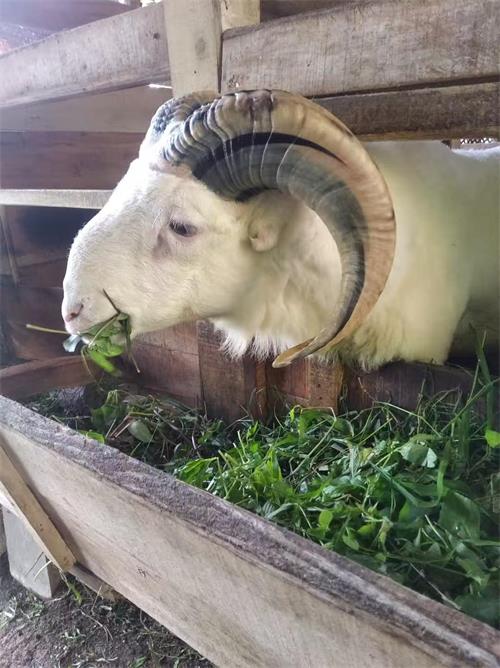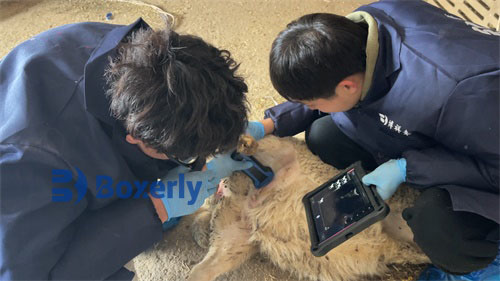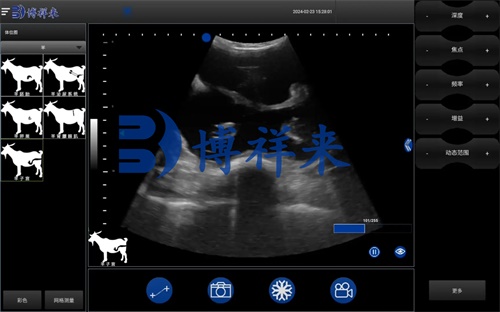As sheep farming moves toward industrialized, high-efficiency production models, understanding the reproductive dynamics of both ewes and rams becomes increasingly important. While seasonal breeding in ewes is well-documented and widely acknowledged, the seasonal reproductive changes in rams have traditionally received less attention from both farmers and researchers.

However, recent advancements in veterinary diagnostics—especially the application of ultrasonography—are helping farmers gain deeper insight into the seasonal fluctuations in ram reproductive performance. By using sheep-specific B-mode ultrasound devices, producers can now non-invasively monitor testicular development and semen quality throughout the year. This technology not only enhances herd fertility management but also supports decision-making about breeding schedules, hormone interventions, and animal welfare.
In this article, I will explore how ultrasound is used to evaluate seasonal changes in rams, share practical examples from global sheep farming practices, and explain why this tool is increasingly essential for modern flock management.
Understanding Seasonal Reproduction in Rams
Photoperiod—the length of day versus night—is the main environmental factor influencing seasonal reproduction in sheep. In temperate climates, most sheep breeds are short-day breeders. This means that reproductive activity increases as daylight decreases, typically beginning in the fall and lasting through winter. While the ewe’s estrous cycle is the focus of most breeding calendars, the ram’s reproductive system also undergoes significant seasonal changes that can affect the success of mating programs.
Studies from countries such as Australia, New Zealand, and Spain have shown that in the non-breeding season—usually during spring and early summer—rams can experience reduced testicular size, lower semen quality, decreased libido, and hormonal imbalances. These changes are subtle and gradual but have measurable impacts on fertility rates.
For years, many producers overlooked these changes, assuming that rams were always ready to breed. However, modern reproductive science has debunked this myth. Rams, like ewes, respond to seasonal cues and require careful management to maintain year-round breeding readiness.
Ultrasound Technology: A Game Changer in Ram Reproductive Monitoring
Ultrasonography has emerged as a reliable and efficient tool for evaluating the reproductive organs of livestock. In rams, ultrasound can provide real-time images of the testicles, epididymis, and scrotal contents. The most commonly used type in this context is the B-mode (brightness mode) ultrasound, which generates two-dimensional grayscale images that reflect tissue density.
By conducting periodic ultrasound scans, veterinarians and producers can measure parameters such as:
-
Testicular volume and symmetry
-
Echotexture (indicating seminiferous tubule health)
-
Presence of abnormalities (e.g., mineralization, fluid accumulation)
-
Consistency in parenchymal structure
-
Epididymal development
These observations are crucial for detecting signs of reproductive regression during the off-season and for assessing the response to hormonal treatments aimed at stimulating sexual activity.

Global Applications: What Farmers Around the World Are Doing
In Australia, where sheep farming plays a key role in agriculture, researchers have used ultrasound to identify the optimal months for semen collection and artificial insemination. Australian Merino rams, for instance, show a marked reduction in testicular size during late spring. By adjusting breeding programs to account for these changes, producers can better synchronize mating with peak fertility periods.
In Spain, where Mediterranean sheep breeds are common, veterinary researchers have combined ultrasonography with blood hormone profiling to develop precise protocols for hormone supplementation during low-libido periods. Using low doses of testosterone in conjunction with human chorionic gonadotropin (hCG), rams with reduced sexual drive have shown marked improvement in libido and semen parameters within 12 days of treatment.
In the United States and the United Kingdom, universities and research farms have begun offering extension programs to teach farmers how to interpret ram ultrasound images. These educational initiatives aim to make producers more self-sufficient and data-driven in their breeding strategies.
Hormonal Interventions and Feedback Mechanisms
One innovative approach to addressing seasonal reproductive decline in rams involves stimulating the hypothalamic-pituitary-gonadal (HPG) axis using exogenous hormones. When low-dose testosterone and hCG are administered in combination, they help enhance the sensitivity of Leydig cells to luteinizing hormone (LH). This promotes endogenous testosterone secretion and reactivates sexual behavior.
The mechanism works like this:
-
Testosterone and hCG mimic the natural hormones in the ram’s body.
-
These substances stimulate the brain’s hypothalamus and pituitary gland to produce more GnRH and LH.
-
The LH then stimulates the testes to produce more testosterone naturally.
-
This leads to restored libido and improved sperm quality.
This treatment is especially useful for “teaser” rams (also known as “marker rams”) used to identify ewes in heat. Ensuring that these rams maintain strong libido year-round is essential for accurate estrus detection and efficient breeding.
Importance of Year-Round Reproductive Monitoring
Rams are not simply breeding tools—they are the cornerstone of a flock’s genetic progress and reproductive efficiency. A single ram often services 30 to 50 ewes, meaning that any decline in his fertility can affect the entire flock’s productivity.
Maintaining the reproductive health of rams is therefore critical to the success of factory-style or large-scale sheep operations. Regular ultrasound assessments allow for early identification of subfertile rams, better breeding selection, and timely veterinary intervention. Moreover, it reduces reliance on subjective methods such as visual appraisal or testicular palpation alone.

Comparative Benefits of Ultrasound Monitoring
| Feature | Traditional Methods | Ultrasound-Based Approach |
|---|---|---|
| Palpation-based assessment | Subjective, error-prone | Objective, visual confirmation |
| Semen quality testing | Invasive, time-consuming | Predictive through testicular size |
| Hormonal level evaluation | Requires lab access | Guided by ultrasound changes |
| Libido assessment | Observational, inconsistent | Reinforced by testicular data |
Ultrasound thus acts as a bridge between clinical observation and laboratory diagnostics, making it ideal for both small and large-scale operations.
Best Practices for Implementing Ram Ultrasonography
To ensure accurate and consistent results, consider the following best practices:
-
Use a sheep-specific B-mode ultrasound probe for better image resolution.
-
Perform scans at consistent times of the day and under similar environmental conditions.
-
Keep records of testicular measurements over time to identify trends.
-
Combine ultrasound with hormone profiling and semen analysis when possible.
-
Collaborate with a veterinarian for image interpretation and hormone administration protocols.
Practical Case Study
At a commercial sheep farm in Inner Mongolia, China, ultrasound examinations revealed that several elite breeding rams showed significant testicular shrinkage during the summer months. These animals, previously assumed to be fertile year-round, produced poor semen samples when tested.
After administering a low-dose hormone regimen involving testosterone and hCG, follow-up ultrasounds showed increased testicular volume and improved tissue consistency. By the start of the fall breeding season, these rams had regained full reproductive capacity. The intervention allowed the farm to preserve its high-value genetics and avoid costly replacement.
Why Ram Reproductive Health Deserves More Attention
Despite their central role in breeding, rams often receive less veterinary attention than ewes. This oversight can be costly. As the saying goes, “one ram can make or break a season.” A single subfertile or low-libido ram can result in dozens of empty ewes, missed cycles, and economic losses.
It’s time for producers, veterinarians, and animal scientists to give rams the reproductive care they deserve. Just as we invest in nutritional programs, parasite control, and hoof trimming for overall herd health, reproductive health must become a standard pillar of ram management.

Conclusion: Toward a New Standard in Sheep Reproduction
Ultrasound imaging represents a breakthrough in monitoring and managing the reproductive health of rams throughout the year. As farmers seek to optimize fertility and productivity, integrating ultrasound assessments into routine management offers a non-invasive, data-driven, and cost-effective solution.
By paying attention to seasonal changes in ram reproductive physiology and addressing them through timely interventions—including hormone therapy—producers can achieve more reliable mating outcomes, better lambing rates, and greater overall profitability.
In the industrialized sheep farming model, where every cycle and every lamb counts, the ram’s reproductive health is not just important—it’s essential. And ultrasound is the tool that ensures no detail goes unnoticed.
References:
-
Fernandez Abella, D. (2000). “Reproductive seasonality in rams: A review.” Small Ruminant Research, 38(3), 161–171.
-
Cordeiro, M. F., et al. (2015). “Ultrasonographic evaluation of testicular echotexture and semen quality in rams.” Journal of Animal Reproduction, 12(4), 502–510.
-
Hafez, B., & Hafez, E. S. E. (2000). “Reproduction in Farm Animals.” 7th Edition. Lippincott Williams & Wilkins.
-
Australian Sheep CRC. (2022). “Managing Ram Fertility Year-Round.” https://www.sheepcrc.org.au
-
University of Zaragoza Veterinary Faculty (Spain). “Seasonal Effects and Hormonal Control in Ram Fertility.” (2023) Extension Bulletin.